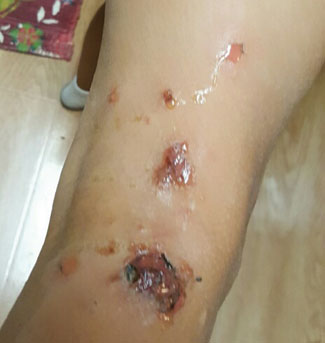A challenging case of persistent scratching

A 6-year-old, previously healthy male, with no past skin disorders or infections, presents with an unusual, progressive cluster of pruritic lesions on the posterior thigh and popliteal areas of his right leg. The area has been damaged by persistent scratching due to the pruritus. The problem was thought to have started with numerous mosquito bites about 4 weeks earlier. The patient has been seen several times with a variety of anti-infective therapies prescribed, including topical mupirocin, oral trimethoprim-sulfamethoxazole, clindamycin, cephalexin, acyclovir and even one dose of intramuscular ceftriaxone, none of which seem to have had any impact on the lesions, which included early blistering, followed by some crusting, followed by raw, weeping erosions that ultimately dried up. It is likely that scratching may have significantly altered the course. The patient was never sick or febrile, and no other members of the family or close contacts have had similar problems.

Examination revealed the lesions (Figures 1 and 2). Multiple attempts were made to identify an infectious cause by herpes simplex and varicella-zoster PCRs, which were negative, with a standard culture growing a mixture of organisms, as one might expect. A biopsy was done at two different locations (Figure 3) 16 days after the first visit, which was about 20 days after the onset. The biopsy results revealed “eosinophilic dermatitis.”

What’s your diagnosis?
A. Allergic reaction to insect bites
B. Blister beetle reaction
C. Poison rash
D. Wells syndrome
As stated above, this is a challenging case of a condition I had never seen before, known as Wells syndrome (choice D). The diagnosis is made on biopsy, which is characterized by eosinophilic cellulitis, and it was described by G.C. Wells in 1971 in the dermatology literature. Obviously, dermatologists are much more aware of this condition, which is confirmed by biopsy that reveals the characteristic tissue eosinophils. It is thought to result from dysregulation of this response triggered by various insect bites, including mosquitoes. It is unclear what the natural progression would be, as the lesions are frequently damaged by scratching. There are seven variations of this syndrome, ranging from plaque-type to fixed drug eruption-like. In this case, the patient had the papulovesicular type. Treatment is usually topical steroids or occasionally systemic steroids, and protection from further damage, such as scratching.

Obviously, if secondary infection occurs, that should be treated as well. Some have advocated the use of dapsone, an antimicrobial agent (a sulfone) normally used for Hansen disease (leprosy).
Allergic reactions to insect bites happen all the time but do not persist and progress in this fashion.

Blister beetle reactions can result in a persistent, progressive lesion. However, the progressiveness is within the lesion itself and not multiple other lesions, and as the lesion heals, it retains the shape of the original injury made by the vesicant liberated by the beetle (Figure 4).
Poison ivy can provoke an intense inflammatory reaction in sensitized patients, usually within a few hours. Often times, discrete streaking lesions with some blistering can be seen. In children who get the toxin (urushiol) on their hands, it can easily be spread to their face and anywhere else they happen to touch or scratch. One would not expect this reaction to persist as long as Wells syndrome.
- Reference:
- Wells GC. Trans St Johns Hosp Dermatol Soc. 1971;57:46-56.
- For more information:
- James H. Brien, DO, is with the department of infectious diseases at McLane Children’s Hospital, Baylor Scott & White Health, Texas A&M College of Medicine in Temple, Texas. He also is a member of the Infectious Diseases in Children Editorial Board. Brien can be reached at jhbrien@aol.com.
Disclosure: Brien reports no relevant financial disclosures.
